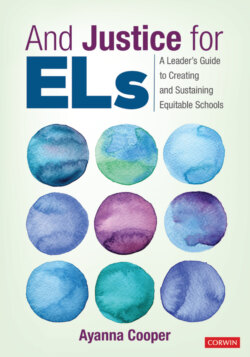Читать книгу And Justice for ELs - Ayanna Cooper - Страница 8
На сайте Литреса книга снята с продажи.
ОглавлениеIntroduction
This book is a result of the numerous conversations, experiences, and frustrations I’ve had as an educator committed to culturally and linguistically diverse learners. Despite the number of initiatives focused on diverse student populations, specifically English learners (ELs), achievement gaps persist. From my experience, whether in the continental United States or abroad, the postal codes and climates may be different, but the challenges being faced by ELs and their learning communities are far too similar. The issues they confront are civil rights issues. I do not believe that educators wake up each morning with the intent of violating the civil rights of their students, but, unfortunately, it happens. It happens unintentionally yet regularly. Though we have made some strides by highlighting the rich cultural and linguistic diversity ELs possess, deficit mindset, anti-inclusive practices, racist rhetoric, and pobrecito, attitudes persist. Efforts to close the achievement gap are taking too long, despite all of our best efforts. Our students cannot wait any longer!
I approached writing this book as an ethnographer, using my field notes to explain and provide insight into a phenomenon I had witnessed time and time again. I’ve found that the fewest number of professional learning opportunities have been designed and facilitated specifically for the needs of school leaders who educate ELs. I was reminded recently that you don’t have to be an expert to ask the right questions. This book is guided by a primary question: If educators are truly committed to equity and access for all, then why are certain subgroups of students, particularly ELs, still lagging behind?
This book is intended to serve as a conversation starter, one that poses a number of questions that are aimed at invoking critical thinking and self-reflection. The book is a form of social justice, activism, and response to the question of why ELs are being left behind. For school leaders, this book is particularly important because daily choices are made in schools that will have long-term implications, both positive and negative, for their ELs. It is my hope that this book serves as a resource and a new professional learning opportunity that will contribute to the construction of not one, but many bridges.
What This Book Is
In response to the plight of marginalized subgroups, many novice and experienced school leaders are looking for new approaches to the work. In response to that need, in just five chapters I address the civil rights mandates for ELs and how to best implement and sustain practices to support positive outcomes for students learning English as an additional language.
The chapters each get to the “heart of the matter” in a practical way—a way that does not exclude those without extensive backgrounds in English language teaching and learning. Because many such school leaders are already serving as advocates and leading schools with subgroups of ELs, this book is designed to welcome and invite them to the conversation. Each chapter includes one or more examples of situations that play out in schools on a daily basis that directly impact ELs and their families, a “What Would You Do” scenario, follow-up questions, and a list of related resources aimed at continuing these conversations. This book is a resource to help guide educators in learning about and leading schools with culturally and linguistically diverse learners in a way that assures linguistic equity.
What This Book Is Not
This book does not address all of the variables that contribute to the current state of EL achievement in the United States. It does not profess to have all of the answers. This book can support educators in examining their own contexts (rural, suburban, and urban) by encouraging them to make necessary improvements. It does not subscribe to a one-size-fits-all approach to creating and sustaining equitable schools. Each learning community is unique, with its own ecosystem of complexities and characteristics. Because it is impossible to provide specific advice or guidance for every possible situation, through this book’s five chapters I have highlighted the “need-to-knows” necessary for school leaders to be able to make informed decisions about and for the ELs they serve.
How This Book Can Be Used
Warning: This book may be used to upset the status quo. This book may be used to challenge prior practices, systems, and structures. It can be used to inform individuals and learning communities who not only seek to deepen their understanding of EL needs and requirements but who want to be prepared to do what is necessary. This includes those who are influential in preservice educator programs, education policy, education reform, and the like. Cognitive dissonance laced with the spirit of activism can lead to more informed decision-making, collaborative partnerships, and, ultimately, the capacity to create and sustain equitable schools with ELs.
This book is dedicated to my parents, Deborah Wornum and the late Leonard Johnson, and to my stepfather, the late Bruce Wornum. It is also dedicated to my husband Ronnie and our children, Ronnie and Breanna Cooper, and my grandson Hendrix Cooper. Thank you for helping me to become the person I am today and will become in the future.
